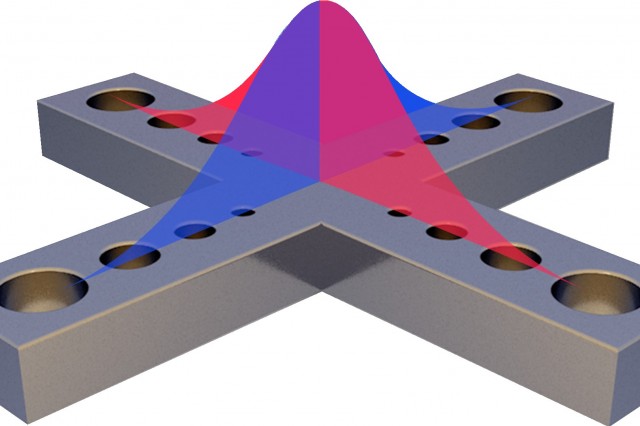Army Researchers and Dr. Mikkel Heuck and Prof. Dirk Englund of the Massachusetts Institute of Technology have demonstrated the feasibility of a quantum logic gate comprised of photonic circuits and optical crystals.
Researchers can engineer cavities in the crystals that temporarily trap photons inside. Through this method, the quantum system can establish two different possible states that a qubit can hold: a cavity with a photon (on) and a cavity without a photon (off). These qubits can then form quantum logic gates, which create the framework for the strange states.
ABSTRACT
We show that relatively simple integrated photonic circuits have the potential to realize a high fidelity deterministic controlled-phase gate between photonic qubits using bulk optical nonlinearities. The gate is enabled by converting travelling continuous-mode photons into stationary cavity modes using strong classical control fields that dynamically change the effective cavity-waveguide coupling rate. This architecture succeeds because it reduces the wave packet distortions that otherwise accompany the action of optical nonlinearities. We show that high-fidelity gates can be achieved with self-phase modulation. The gate fidelity asymptotically approaches unity with increasing storage time for an incident photon wave packet with fixed duration. We also show that dynamically coupled cavities enable a trade-off between errors due to loss and wave packet distortion. Our proposed architecture represents a new approach to practical implementation of quantum gates that is room-temperature compatible and only relies on components that have been individually demonstrated.

Brian Wang is a Futurist Thought Leader and a popular Science blogger with 1 million readers per month. His blog Nextbigfuture.com is ranked #1 Science News Blog. It covers many disruptive technology and trends including Space, Robotics, Artificial Intelligence, Medicine, Anti-aging Biotechnology, and Nanotechnology.
Known for identifying cutting edge technologies, he is currently a Co-Founder of a startup and fundraiser for high potential early-stage companies. He is the Head of Research for Allocations for deep technology investments and an Angel Investor at Space Angels.
A frequent speaker at corporations, he has been a TEDx speaker, a Singularity University speaker and guest at numerous interviews for radio and podcasts. He is open to public speaking and advising engagements.


Just imagine 2 fighter planes against eachother both using quantum computer for the best attack… who will win ?…
(a multiverse solution, each plane wins in its own realm) or will one reality colaps..
Accept we have quantum computing, it is just extremely expensive at the moment but has had costs decrease rapidly over the decade. We can achieve fusion right now, it just is inefficient. Quantum computers will be widespread before fusion, it’ll make way more money for governments rather than cheap energy.
Even if it doesn’t reach room temp. they’ll still be drastically cheaper is the temperature is pushed higher. The best practical superconductor we have is around -45 degrees fahrenheit, it’s way better than the 2013 d-wave computer that cost millions of dollars to cool when now it’s just hundreds of dollars. It needs to be room temperature to reach most people but just any improvement does alot.
Didn’t they find with Josephson junctions that you lost the advantages when you went to higher temperature superconductors? Not that they didn’t work, but they slowed down enough to not be worth it.
I wonder if the same might be the case for qbits.
I think quantum computing will be just like fusion power, always X years to get it working properly
学习啦,很久没浏览过了!